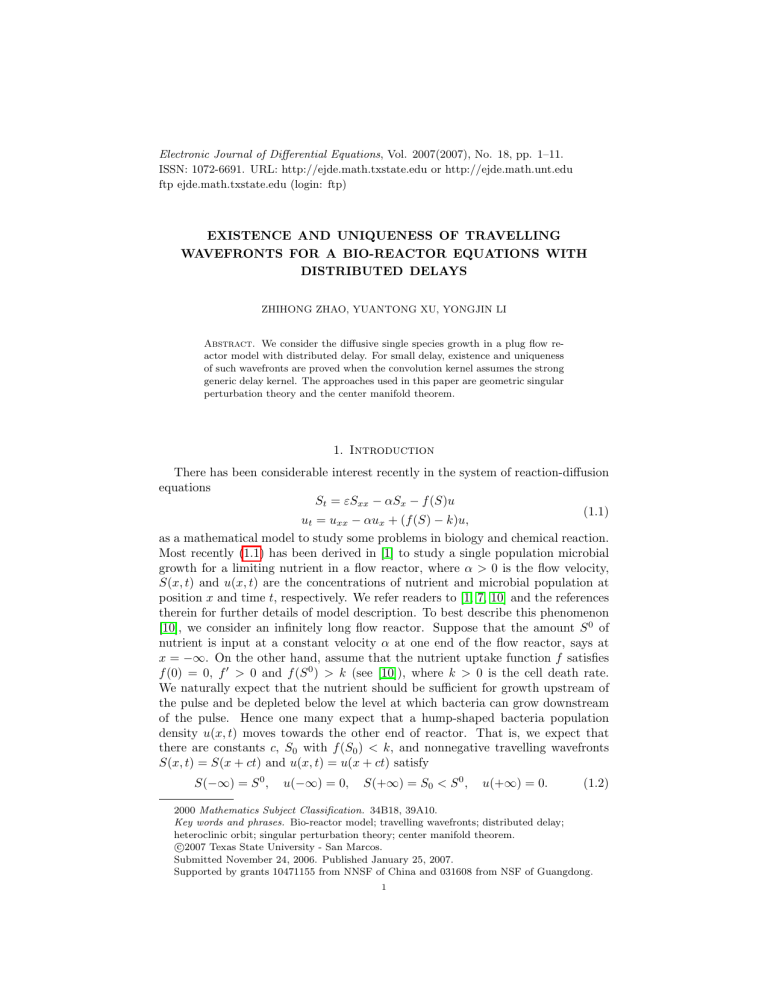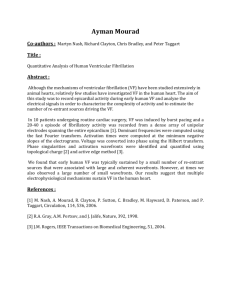Electronic Journal of Differential Equations, Vol. 2007(2007), No. 18, pp.... ISSN: 1072-6691. URL: or
advertisement

Electronic Journal of Differential Equations, Vol. 2007(2007), No. 18, pp. 1–11.
ISSN: 1072-6691. URL: http://ejde.math.txstate.edu or http://ejde.math.unt.edu
ftp ejde.math.txstate.edu (login: ftp)
EXISTENCE AND UNIQUENESS OF TRAVELLING
WAVEFRONTS FOR A BIO-REACTOR EQUATIONS WITH
DISTRIBUTED DELAYS
ZHIHONG ZHAO, YUANTONG XU, YONGJIN LI
Abstract. We consider the diffusive single species growth in a plug flow reactor model with distributed delay. For small delay, existence and uniqueness
of such wavefronts are proved when the convolution kernel assumes the strong
generic delay kernel. The approaches used in this paper are geometric singular
perturbation theory and the center manifold theorem.
1. Introduction
There has been considerable interest recently in the system of reaction-diffusion
equations
St = εSxx − αSx − f (S)u
(1.1)
ut = uxx − αux + (f (S) − k)u,
as a mathematical model to study some problems in biology and chemical reaction.
Most recently (1.1) has been derived in [1] to study a single population microbial
growth for a limiting nutrient in a flow reactor, where α > 0 is the flow velocity,
S(x, t) and u(x, t) are the concentrations of nutrient and microbial population at
position x and time t, respectively. We refer readers to [1, 7, 10] and the references
therein for further details of model description. To best describe this phenomenon
[10], we consider an infinitely long flow reactor. Suppose that the amount S 0 of
nutrient is input at a constant velocity α at one end of the flow reactor, says at
x = −∞. On the other hand, assume that the nutrient uptake function f satisfies
f (0) = 0, f 0 > 0 and f (S 0 ) > k (see [10]), where k > 0 is the cell death rate.
We naturally expect that the nutrient should be sufficient for growth upstream of
the pulse and be depleted below the level at which bacteria can grow downstream
of the pulse. Hence one many expect that a hump-shaped bacteria population
density u(x, t) moves towards the other end of reactor. That is, we expect that
there are constants c, S0 with f (S0 ) < k, and nonnegative travelling wavefronts
S(x, t) = S(x + ct) and u(x, t) = u(x + ct) satisfy
S(−∞) = S 0 ,
u(−∞) = 0,
S(+∞) = S0 < S 0 ,
u(+∞) = 0.
(1.2)
2000 Mathematics Subject Classification. 34B18, 39A10.
Key words and phrases. Bio-reactor model; travelling wavefronts; distributed delay;
heteroclinic orbit; singular perturbation theory; center manifold theorem.
c 2007 Texas State University - San Marcos.
Submitted November 24, 2006. Published January 25, 2007.
Supported by grants 10471155 from NNSF of China and 031608 from NSF of Guangdong.
1
2
Z. ZHAO, Y. XU, Y. LI
EJDE-2007/18
The equations satisfied by S(z) and u(z), where z = x + ct are
0 = εS 00 − (α + c)S 0 − f (S)u
0 = u00 − (α + c)u0 + (f (S) − k)u.
(1.3)
From (1.2) and (1.3), we get S0 must satisfy
Z
0
+∞
(α + c)(S − S0 ) = k
u(z)dz.
(1.4)
−∞
The question of the existence of travelling wavefronts of (1.1) and (1.2) has recently
been solved that can be summarized as follows.
Proposition 1.1. Assume ε ≥ 0, k > 0 are constants, and suppose that f satisfies
f (0) = 0, f 0 > 0 and f (S ∗ ) = k for some positive number S ∗ . Then, given S 0 >
S ∗ and there is a unique S0 ∈ (0, S ∗ ) such that (1.1) has a travelling wavefronts
S(x + ct),
p u(x + ct) satisfying the boundary condition (1.2) if and only if c + α ≥
C ∗ := 4(f (S 0 ) − k). Moreover, S(z) is strictly decreasing and u(z) is strictly
positive for z ∈ R.
The objective of the present paper is to address the question of the existence and
uniqueness of travelling wavefronts solution of the following more general version
of the system (1.1) with ε = 0,
St = −αSx − f (S)(g ∗ u)
ut = uxx − αux + (f (S) − k)(g ∗ u),
where the convolution g ∗ u is defined by
Z t
(g ∗ u)(x, t) =
g(t − s)u(x, s)ds
(1.5)
(1.6)
−∞
and the kernel g : [0, ∞) → [0, ∞) satisfies
Z
g(t) ≥ 0,
∀t ≥ 0
and
∞
g(t)dt = 1.
(1.7)
0
The delay kernel g are frequently of the form
1
t
g(t) = δ(t − τ ), g(t) = e−t/τ , g(t) = 2 e−t/τ .
(1.8)
τ
τ
In each of these cases, the parameter τ > 0 measures the delay. The first of these
kernels gives rise to a model having a discrete time-delay, where δ denotes Dirac’s
delta function. The other two kernels in (1.8) are called weak and strong generic
delay kernels. The “weak” case g(t) = τ1 e−t/τ reflects the idea that the importance
of the past decreases exponentially the further one looks into the past. The “strong”
case g(t) = τt2 e−t/τ can be regarded as a smoothed out version of the discrete delay
case g(t) = δ(t − τ ). This strong kernel implies that a particular time in the past,
namely τ time units ago, is more important than any other since kernel achieves
its unique maximum at t = τ .
The remaining part of this paper is organized as follows. Section 2 is devote
to some preliminary discussion mainly focus on the particular case of the kernel.
In Section 3, we establish the existence and uniqueness of travelling wavefronts
solutions when τ is small. Geometrical singular perturbation theory and the center
manifold theory play a major role in the proofs.
EJDE-2007/18
TRAVELLING WAVEFRONTS FOR A BIO-REACTOR EQUATION
3
2. preliminaries
The purpose of this section is to establish propositions that will serve main proof
of the existence and uniqueness of the travelling wavefront.
At first, the results on travelling fronts for the non-delay equation is needed.
(1.3) with ε = 0 can read as a system of first-order equations
u00 = (c + α)u0 − (f (S) − k)u
(2.1)
S 0 = −f (S)u/(c + α)
which is equivalent to (see [10])
u0 = (c + α)[−G(S 0 ) + u + G(S)]
(2.2)
S 0 = −f (S)u/(c + α)
where
Z
S
G(S) = S − k
S∗
1
ds,
f (s)
S > 0.
(2.3)
The function G satisfies
f (S) − k
, G00 (S) > 0. (2.4)
f (S)
The following lemma yields the existence of a travelling wavefront solution of the
non-delay equation (2.2).
p
Lemma 2.1 ([10]). If c + α ≥ C ∗ := 4(f (S 0 ) − k), then in the (S, u) phase
plane, a heteroclinic connection exists between the critical points (S, u) = (S 0 , 0)
and (S0 , 0) for S 0 > S ∗ , G(S0 ) = G(S 0 ) and S(·) is strictly decreasing and u(·) is
positive and unimodal.
G(0+ ) = G(+∞) = +∞,
G(S ∗ ) = S ∗ ,
G0 (S) =
We return now to the delay equation (1.5). The travelling wavefronts is a solution
of the form S(x, t) = S(z), u(x, t) = u(z), where z = x + ct and c > 0 is called wave
speed, satisfies
0 = −(α + c)S 0 − f (S)(g ∗ u)
(2.5)
0 = u00 − (α + c)u0 + (f (S) − k)(g ∗ u)
with
Z ∞
(g ∗ u)(z) =
g(w)u(z − cw)dw.
(2.6)
0
We shall seek leftward-moving waves, thus we take
S(−∞) = S 0 ,
S(+∞) = S0 ,
u(−∞) = 0,
u(+∞) = 0.
(2.7)
Next, we shall analyze (2.5) for travelling wavefronts in the particular case when
the kernel g is the third of (1.8), the strong generic delay case. The corresponding
calculations for the weak kernel are similar and will be omitted. Recall that the
parameter τ measures the delay. It is useful to reference (2.5) as
u00 = (c + α)u0 − (f (S) − k)(g ∗ u)
S0 = −
Thus
g(t) =
f (S)
(g ∗ u).
(c + α)
t −t/τ
e
,
τ2
τ > 0,
(2.8)
4
Z. ZHAO, Y. XU, Y. LI
and we define
Z
p(z) = (g ∗ u)(z) =
0
∞
EJDE-2007/18
t −t/τ
e
u(z − ct)dt.
τ2
Differentiating with respect to z, we obtain
dp
1
=
(p − q),
dz
cτ
where
Z ∞
1 −t/τ
q(z) =
e
u(z − ct)dt.
τ
0
Similarly,
dq
1
=
(q − u).
dz
cτ
If we further denote u0 = v, then (2.8) with the kernel given above can be replaced
by the system
u0 = v
v 0 = (c + α)v − (f (S) − k)p
f (S)
p
(c + α)
cτ p0 = p − q
S0 = −
(2.9)
cτ q 0 = q − u,
Note that if τ = 0, then (2.9) reduces to
u0 = v
v 0 = (c + α)v − (f (S) − k)u
(2.10)
0
S = −f (S)u/(c + α),
the autonomous ordinary differential system for travelling wavefronts solutions of
(1.5) in the non-delay case.
For τ > 0, (2.9) defines a system of ODEs whose solutions evolve in the fivedimensional (u, v, S, p, q) phase space. In this phase space, E = {(0, 0, S, 0, 0)} is
the one-dimensional manifold of critical for (2.9). A travelling wavefronts solution
of the (2.8) will exist if among the solutions of (2.9), there exists a heteroclinic
connection between the two critical points in E.
Then, we will show that (2.9) has travelling wavefronts for sufficiently small τ > 0
by the geometric singular perturbation theory and the center manifold theorem.
Note that when τ = 0, system (2.9) does not define a dynamical system in R5 .
This problem may be overcome by the transformation z = τ η, under which the
system becomes
u̇ = τ v
v̇ = τ [(c + α)v − (f (S) − k)p]
f (S)
(2.11)
p]
(c + α)
cṗ = p − q
cq̇ = q − u,
where a dot on top of a variable denotes differentiation with respect to η. We refer
to (2.9) as the slow system and (2.11) as the fast system. The two are equivalent
when τ > 0.
Ṡ = τ [−
EJDE-2007/18
TRAVELLING WAVEFRONTS FOR A BIO-REACTOR EQUATION
5
Consider the fast system (2.11), for τ = 0, then the flow of that system is confined
to the set
M0 = {(u, v, S, p, q) ∈ R5 : p = u, q = u},
(2.12)
which is, therefore, a three-dimensional invariant manifold for (2.9). E ⊂ M0 and
an easy calculation shows that the eigenvalues of the Jacobian, on setting τ = 0,
has 3 zero eigenvalues corresponding the tangent space of M0 and two same positive
eigenvalues, namely 1c . Thus, M0 is normally hyperbolic manifold.
According to Fenichel’s Invariant Manifold Theorem (see [4], [8]), there exist a
locally invariant three-dimensional manifold Mτ with τ is sufficiently small. It can
be written in the form
Mτ = (u, v, S, p, q) ∈ R5 : p = u + e
h1 (u, v, S, τ ), q = u + e
h2 (u, v, S, τ ) , (2.13)
where the functions e
h1 , e
h2 are smooth functions defined on a compact domain, and
e
e
satisfies h1 (u, v, S, 0) = h2 (u, v, S, 0) = 0 and thus that
e
h1 (u, v, S, τ ) = τ h1 (u, v, S, τ ), e
h2 (u, v, S, τ ) = τ h2 (u, v, S, τ ).
(2.14)
Since τ is small, e
h1 , e
h2 can be expanded into the form of Taylor series about τ , and
h1 , h2 can express as
1
2
1
2
h1 (u, v, S, τ ) = h1 (u, v, S) + τ h1 (u, v, S) + . . . ,
(2.15)
h2 (u, v, S, τ ) = h2 (u, v, S) + τ h2 (u, v, S) + . . . .
By substituting (2.14) into (2.9), we see that h1 , h2 must satisfy
c(v+τ (
∂h1
∂h1
∂h1 f (S)
v+
((c+α)v−(f (S)−k)(u+τ h1 ))−
(u+τ h1 ))) = h1 −h2
∂u
∂v
∂S (c + α)
and
c(v + τ (
∂h2
∂h2
∂h2 f (S)
v+
((c + α)v − (f (S) − k)(u + τ h1 )) −
(u + τ h1 ))) = h2
∂u
∂v
∂S (c + α)
Substitute (2.15) into the above two equations and comparing powers of τ yields,
we obtain
h1 (u, v, S, τ ) = 2cv + 3τ c2 ((c + α)v − (f (S) − k)u) + . . . ,
h2 (u, v, S, τ ) = cv + τ c2 ((c + α)v − (f (S) − k)u) + . . . .
(2.16)
We study the flow of (2.9) restricted to Mτ and show that it has a travelling
front solution. The slow system (2.9) restricted to Mτ is given by
u0 = v
v 0 = (c + α)v − (f (S) − k)(u + τ h1 (u, v, S, τ ))
(2.17)
f (S)
S =−
(u + τ h1 (u, v, S, τ )).
c+α
0
which is equal to
u0 = v
v 0 = (c + α)v − (f (S) − k)u + τ h1 (u, v, S, τ )
f (S)
u + τ h2 (u, v, S, τ ),
S =−
c+α
0
(2.18)
6
Z. ZHAO, Y. XU, Y. LI
EJDE-2007/18
(S)
where h1 (u, v, S, τ ) = −(f (S) − k)h1 (u, v, S, τ ), h2 (u, v, S, τ ) = − fc+α
h1 (u, v, S, τ ).
Note that when τ = 0, this system reduces to the corresponding system for the
non-delay (2.10). It is easily verified that for τ > 0, system (2.18) still has onedimensional manifold of critical E = (0, 0, S).
3. main results
In this section, we discuss the existence and uniqueness of travelling wavefronts
solutions of (1.5)
The ideas of the following proof are similar to those of Smith and Zhao [10] who
were considering the question of persistence of travelling wavefronts solutions in an
equation with a fourth-order spatial derivative but no time delay.
Note that system (2.10) is equivalent to (2.1). According to Lemma 2.1 and
[10], for 0 < S0 < S ∗ and c + α > 0, the positive branch of the one-dimensional
stable manifold of (0, 0, S0 ) for system (2.10), W0s (S0 ), connect to (0, 0, S 0 ), where
G(S0 ) = G(S 0 ) > S ∗ . We want to show that for τ > 0 but very small, the
positive branch of one-dimensional stable manifold of (0, 0, S0 ) for system (2.18),
Wτs (S0 ), also connects to (0, 0, S 0 ). We may describe the local stable manifold as
the forward orbit {xτ (z) : z ≥ 0} of (2.18) through a point xτ := xτ (0) on the local
stable manifold, which depends continuously on τ , and by a compact piece of the
global stable manifold we mean {xτ (z) : z ≥ −Z} (Z 1), with endpoint xτ (−Z).
We expect that such a compact piece of WτS (S0 ) has endpoint nearby (0, 0, S 0 ) for
small τ > 0. The next result indicates what happens to the backward orbit through
this endpoint.
Lemma 3.1. Given S 0 > S ∗ and δ0 > 0, there exists τ0 , δ > 0 such that if
ξ = (u, v, S) satisfies |ξ − (0, 0, S 0 )| < δ and 0 ≤ τ < τ0 , then the solution of
starting at ξ, xτ (z) = (uτ (z), v τ (z), S τ (z)), satisfies |xτ (z) − (0, 0, S 0 )| < δ0 for all
z < 0, and there exist β τ = (0, 0, S τ ) such that xτ (z) → β τ as z → −∞.
Proof. Appending an equation for τ to (2.18), we shall argument the system (2.18)
with equation for τ .
u0 = v
v 0 = (c + α)v − (f (S) − k)u + τ h1 (u, v, S, τ )
S0 = −
f (S)
u + τ h2 (u, v, S, τ )
c+α
τ0 = 0
(3.1)
We apply the center manifold theory in [2] to the time reversed system (3.1). Note
that this four-dimensional system has the two-dimensional manifold of critical given
by N = {u = v = 0}. Focus on one of steady states N 0 = (0, 0, S 0 , 0). A change of
variables S → S1 given by
S1 = S − S 0 +
v
f (S 0 )
(u −
),
r
c+α
r = f (S 0 ) − k.
(3.2)
EJDE-2007/18
TRAVELLING WAVEFRONTS FOR A BIO-REACTOR EQUATION
7
Translates N 0 to the origin and de-couples the linear parts of the time reversed
system (3.1). Then resulting system is
u0 = −v
v 0 = ru − (c + α)v + (f (S) − f (S 0 ))u − τ h1 (u, v, S, τ )
1
S10 =
(f (S) − f (S 0 ))u − τ h2 (u, v, S, τ )
(c + α)r
τ0 = 0
(3.3)
where S is determined by (3.2). We let x = (S1 , τ ) and y = (u, v), then (3.3) has
the form
x0 = Ax + f (x, y)
(3.4)
y 0 = By + g(x, y),
0 −1
where A is the zero matrix and B =
where C = c + α, all the eigenvalues
r −C
of B have negative real parts,
!
f (S)−f (S 0 )
u
−
τ
h
(u,
v,
S,
τ
)
2
Cr
f (x, y) = f (u, v, S1 , τ ) =
0
and
0
.
(f (S) − f (S 0 ))u − τ h1 (u, v, S, τ ))
We have f (0, 0) = 0, f 0 (0, 0) = 0, and g(0, 0) = 0, g 0 (0, 0) = 0. [2, Theorem 1]
asserts there exists a center manifold for (3.3), but we already know that the center
manifold which is unique in our case, is just the manifold of critical N (see [10]).
The dynamical on N is trivial:
S10 = 0
(3.5)
τ 0 = 0,
Since critical point (S1 , τ ) = (0, 0) is stable for the dynamics on N , from [2, throem
2], we get that the origin is stable for (3.3). Furthermore, by the second assertion
of [2, Theorem 2], a solution (u(z), v(z), S1 (z), τ ) of (3.3) which start (0, 0, S10 , τ )
near the origin, such that as z → +∞,
g(x, y) = g(u, v, S1 , τ ) =
u(z) = O(e−γz ),
v(z) = O(e−γz ),
S1 (z) = S10 + O(e−γz ),
where γ > 0. Thus, we get S(z) = S 0 + S10 + O(e−γz ). This is exactly what we
assert above.
Now we prove the main results in this section.
Theorem 3.2. Let S0 satisfy 0 < S0 < S ∗ and let S 0 > S ∗ satisfy G(S 0 ) = G(S0 ).
If τ > 0 is sufficiently small and c + α > 0 the system (1.5) has a unique travelling
wavefronts solution (S(z), u(z))(z = x + ct) connecting (S 0 , 0) and (S0 , 0) with
u(z) > 0 for z ≈ +∞.
Proof. For 0 < S0 < S ∗ , by [8, Fenichel Invariant Manifold Theorem 2], “compact
pieces” of the positive branch of the one-dimensional stable manifold of (0, 0, S0 ) for
(2.18), WτS (S0 ), lie within O(τ ) of, and are diffeomorphic to W0S (S0 ). But W0S (S0 )
connects (0, 0, S0 ) to (0, 0, S 0 ) by Lemma 2.1. If S 0 satisfies G(S 0 ) = G(S0 ), δ0
satisfies 0 < δ0 < 12 (S 0 − S ∗ ) and δ > 0 is as in Lemma 3.1, then there exists
τ1 > 0, such that for all τ ∈ [0, τ1 ), a compact piece of WτS (S0 ) has end point
8
Z. ZHAO, Y. XU, Y. LI
EJDE-2007/18
with in distance δ of (0, 0, S 0 ). We can assume that τ1 < τ0 of Lemma 3.1 and so,
according to Lemma 3.1, the backward continuation of the compact piece of WτS (S0 )
is asymptotic to a point β τ = (0, 0, S τ ) satisfying |β τ − (0, 0, S 0 )| < δ0 . Thus, we
have shown the existence of a heteroclinc orbit for (2.18) connecting (0, 0, S0 ) to
b 0, 0) to
β τ . That is there exists a heteroclinc orbit of (2.9) connecting (0, 0, S,
τ
b
(0, 0, S0 , 0, 0) where β = (0, 0, S).
Next, we prove that Sb = S 0 . As in (1.4), we have
Z +∞
Z +∞
p(z)dz.
(3.6)
(g ∗ u)(z)dz = k
(α + c)(Sb − S0 ) = k
−∞
−∞
From then third equation of (2.9) we find that
p=−
(c + α)S 0
,
f (S)
which, substituting into (3.6) and integrating, lead to
b = G(S0 ),
G(S)
(3.7)
b ) = S 0 . Consequently, the
where G is defined by (2.3), by (2.4) we get that S(τ
0
heteroclinc orbit of (2.9) connecting (0, 0, S , 0, 0) to (0, 0, S0 , 0, 0)
Remark 3.3. The travelling wave solution described in the Theorem 3.2 depends
on τ and c + α.
Note that we make no assertions about the signs of u and S 0 . In the next theory,
we take up these issues.
p
Theorem 3.4. Let S0 satisfies 0 < S0 < S ∗ and c + α > C ∗ := 4(f (S 0 ) − k).
If τ > 0 is sufficiently small, then the travelling wavefronts solution described in
Theorem 3.2, (S(x + ct), u(x + ct)), has the property that S(·) is strictly decreasing
and u(·) is positive and unimodal.
Proof. For τ = 0, we can get (2.10) is the same as (2.1) and from the second
equation of (2.1), u(z), u0 (z) satisfies
u0 (z)
u0 (z) f (S(z))
=− 0
.
u(z)
S (z) c + α
Letting z → −∞, from [2, Corollary 2.1], the ratio approaches
2(
0
r0
1
r0
c+α
)[
<
,
1 ] < 2
c + α 1 + (1 − χ) 2
c+α
2
2
(S )−k)
where χ = 4(f(c+α)
and we use (c+α)
> r0 = f (S 0 ) − k in the last inequality. If
2
4
Z is sufficiently large, then u(−Z), u0 (−Z) > 0 and
u0 (−Z)
c+α
<
.
u(−Z)
2
By continuity, for τ > 0 sufficiently small, we have that u > 0 along the part
of the heteroclinic orbit which lies outside the small δ−neighborhood of (0, 0, S 0 )
identified in Lemma 3.1. By choosing Z larger if necessary, we can assume that
EJDE-2007/18
TRAVELLING WAVEFRONTS FOR A BIO-REACTOR EQUATION
9
u(z), v(z), S(z) belongs to the δ−neighborhood of (0, 0, S 0 ) for z < −Z, that u(z) >
0 for −Z ≤ z < ∞, v(−Z) > 0 and that
v(−Z)
c+α
<
.
u(−Z)
2
(3.8)
We wish to show that u(z) > 0 for all z. Therefore, it is only necessary to consider
(u(z), v(z), S(z)) for z ≤ −Z.
It is useful to reverse ”time” by setting z → −z, then we consider the heteroclinic
orbit for (u(z), v(z), S(z)) for z ≥ Z, which belongs to the δ−neighborhood of
(0, 0, S 0 ). Now we replacing (u, v) in (2.18) by polar coordinates (ρ, θ), then we get
ρ2 θ0 = −(c + α)uv + ru2 + v 2 − τ uh1
ρρ0 = −(1 − r)uv − (c + α)v 2 − τ vh1
(3.9)
f (S)
u − τ h2 ,
S =
c+α
where r = f (S) − k depend on S(z). We are interested in (3.9) for z ≥ Z where
2
S(z) − S 0 is so small that (c+α)
− r > 0. By (3.8), we see that (u(Z), v(Z)) belong
4
to the open first quadrant and that
0
0 < θ(Z) = tan−1 (
v(Z)
c+α
) < θ0 := tan−1 (
).
u(Z)
2
If θ(z) = 0(i.e., v = 0), the first equation of (3.9) become ρ2 θ0 = ru2 − τ uh1 substituting (3.8) into it and we get ρ2 θ0 = [r − 3τ 2 c2 r2 ]u2 + O(τ 3 ), for τ is sufficiently
small, the sign of θ0 (z) depend on r, thus θ0 (z) > 0 whenever θ(z) = 0. If θ(z) =
(c+α)2
2 0
θ0 (i.e., v = c+α
− r)u2 − τ uh1
2 u), the first equation of (3.9) become ρ θ = −(
4
2
−r), thus θ0 (z) < 0 whenthe same way we get the sign of θ0 (z) depend on −( (c+α)
4
ever θ(z) = θ0 . Thus, 0 ≤ θ(z) ≤ θ0 for all z ≥ Z and, in particular, u(z) > 0 for
z ≥ Z. Thus, u(z) > 0 for all z.
For the third equation of (2.18) substituting (2.16) into it and we get
u
S 0 = −f (S)u/(c + α) − τ vf (S) + O(τ 2 ) = −f (S)(
+ τ v) + O(τ 2 )
c+α
Since u > 0, τ is sufficiently small, we have S 0 < 0 for all z ∈ R.
From [2], we can get (2.9) is equals to
u0 = (c + α)[−G(S 0 ) + u + G(S)]
f (S)
p
c+α
cτ p0 = p − q
S0 = −
(3.10)
cτ q 0 = q − u
where G is defined by (2.3). It has two critical points (0, S 0 , 0, 0) and (0, S0 , 0, 0).
The linearized matrix J of system (3.10) is
c + α −(c + α)G0 (S)
0
0
0
f (S)
(S)
0
− fc+α
0
c+α p
J(u, S, p, q) =
(3.11)
1
1
0
0
− cτ
cτ
1
1
− cτ
0
0
cτ
10
Z. ZHAO, Y. XU, Y. LI
EJDE-2007/18
The eigenvalues λ of this matrix at critical points satisfy
(cτ )2 λ4 − ((cτ )2 (c + α) + 2cτ )λ3 + (1 + 2cτ (c + α))λ2 − (c + α)λ − (f (S) − k) = 0
At critical point (0, S 0 , 0, 0), for S 0 > S ∗ , sufficiently small τ and c > 0, this
equation has four positive real part. At critical point (0, S0 , 0, 0), for S0 < S ∗ ,
this equation has there positive real part and one negative real part. Then the
heteroclinic orbit of (3.10) approaches (0, S0 , 0, 0) tangent to the eigenvector corresponding to the negative eigenvalue λ− . An easy calculation of the eigenvector on
u − S phase plane leads to its slope:
(c + α)G0 (S)
4u
=
>0
4S
λ− − (c + α)
Since S 0 < 0, then v = u0 is negative when z is very close to +∞. As u(±∞) = 0,
v = u0 admits at least one zero. By the first equation of (3.10) and (2.17), it follows
that
v 0 = u00
= (c + α)G0 (S)S 0 = (k − f (S))p
2
= (k − f (S))u + O(τ )
(3.12)
whenever v(z) = 0.
0
Let z0 be the largest zero of v. Then v (z0 ) ≤ 0 and v < 0, hold for any z > z0 .
Suppose v 0 (z0 ) = 0, for τ is sufficiently small, then (3.12) implies that v 00 (z0 ) =
−f 0 (S)S 0 (z0 )u(z0 )+O(τ 2 ) > 0, hence v(z0 ) = 0 is the local minimum of v(z) around
z0 , which contradicts the choice of z0 . Hence, we get v 0 (z0 ) < 0 i.e., S(z0 ) > S ∗ .
Since S 0 (z) < 0, for all z ∈ R, we get S(z) > S ∗ hold for any z ∈ (−∞, z0 ), hence
v 0 < 0 hold for any z ∈ (−∞, z0 ). Thus, v(z) admits no zero in (−∞, z0 ) and v > 0.
So v = u0 has precisely one zero z0 and v(z) > 0 for all z ∈ (−∞, z0 ) and v(z) < 0
for all z ∈ (z0 , ∞). Hence u(z) is positive and unimodal.
Remark 3.5. We have considered travelling wavefronts of a plug flow reactor model
(1.1) with ε = 0, and with distributed delay in the form of an integral convolution
in time, mainly using strong generic kernel. It should certainly be applicable in
principle to (1.1) with ε > 0 involving time delay
St = εSxx − αSx − f (S)(g ∗ u)
ut = uxx − αux + (f (S) − k)(g ∗ u)
(3.13)
and other coupled system.
References
[1] M. Ballyk, D. Le, D. A. Jones and H. L. Smith, Effects of random motility on microbial
growth and competition in a flow reactor, SIAM J. Appl. Math., 59 (1999), 573-596.
[2] J. Carr, Application of centre manifold theory, in: Applied Mathematical Sciences, Springer,
New York, 35(1981).
[3] W. Ding and M. Han, Traveling wave for diffusive population models with time delays, J.
Biomathematics, 20(2005), 11-16.
[4] N. Fenichel, Geometric singluar perturbation theory for ordinary diffenertial equations, J.
Diff. Eqns., 31(1979), 53-98.
[5] S. A. Gourley, Travelling fronts in the diffusive nicholson’s blowflies equation with distributed
delays, Math. Comput. Modelling, 32 (2000), 843-853.
[6] S. Harris, Traveling waves with dispersive variability and time delay, Phys. Rev. E, 68(2003),
031912, 5pp.
[7] W. Huang, Uniqueness of traveking wave solutions for a biological reaction-diffusion equation, J. Math. Anal. Appl., 316(2006), 42-59.
EJDE-2007/18
TRAVELLING WAVEFRONTS FOR A BIO-REACTOR EQUATION
11
[8] C. K. R. T. Jones, Geometric singular perturbation theory, in: R. Johnson (Ed.), Dynamical
Systems, Lecture Notes in Mathematics, Springer, New York, 1609(1995).
[9] S. Ma, Traveling wavefronts for delayed reaction-diffusion systems via a fixed point theorem,
J. Diff. Eqna., 171(2001), 294-314.
[10] H. L. Smith, X. Q. Zhao, Traveling waves in a bio-reactor model, Nonlinear Anal. Real World
Appl., 5 (2004), 895-909.
[11] Y. Song, Y. Peng and M. Han, Travelling wavefronts in the diffusive single species model
with allee effect and distributed delay, Appl. Math. Comput., 152(2004), 483-497.
[12] J. Wu and X. Zou, Traveling wave fronts of reaction-diffusion system with delay, J. Dyna.
Diff. Equa., 13(2001), 651-687.
[13] X. Zou and J. Wu, Existence of travelling wavefronts in delayed reaction-diffusion system
via monotone iteration method, Proc. Amer. Math. Soc., 125(1997), 2589-2598.
Zhihong Zhao
Department of Mathematics, Sun Yat-sen University, Guangzhou 510275, China
E-mail address: zhaozhihong01@yahoo.com.cn
Yuantong Xu
Department of Mathematics, Sun Yat-sen University, Guangzhou, 510275, China
E-mail address: xyt@mail.sysu.edu.cn
Yongjin Li
Department of Mathematics, Sun Yat-sen University, Guangzhou, 510275, China
E-mail address: stslyj@mail.sysu.edu.cn





